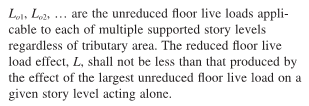EDub24
Structural
- Mar 8, 2016
- 185
I'm trying to figure out how to use live load reduction (ASCE 7-10 section 4.7.2) in a multi-story column with different lives loads per floor. Specifically how to determine the tributary area. Would you consider the tributary area for all of the stories with the same live load above the story in question ignoring the other levels that have different values when determining the reduction? For instance, say you have a 10-story building. The top 2 stories are residential the next 4 levels are various (mechanical, storage etc) and the bottom 4 levels are residential with the ground floor being commercial let's say. Assuming the tributary area, At, for a specific column in question is the same at all levels would the 'effective' tributary area (for use in the LL reduction equation) for each of the residential levels be At and 2*At for the top two levels followed by 3*At, 4*At, 5*At and 6*At for the bottom 4 levels (basically ignoring the intermittent levels with differing live loads)? Thanks!







